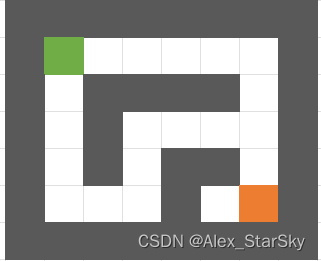经典算法-遗传算法的解走迷宫例子
经典算法-遗传算法的一个简单例子
使用遗传算法走迷宫,如果能从起点顺利走到终点,就能获胜。
迷宫如下图所示,绿点为迷宫起点,橙色点为迷宫终点。
LLM大模型相关文章:
大模型查询工具助手之股票免费查询接口
GPT实战系列-LangChain + ChatGLM3构建天气查询助手
GPT实战系列-大模型为我所用之借用ChatGLM3构建查询助手
GPT实战系列-简单聊聊LangChain
GPT实战系列-Baichuan2本地化部署实战方案
GPT实战系列-大话LLM大模型训练
GPT实战系列-ChatGLM3本地部署CUDA11+1080Ti+显卡24G实战方案
定义迷宫地图和起终点
# 定义迷宫的地图和起点、终点
maze = [
[1, 1, 1, 1, 1, 1, 1, 1],
[1, 0, 0, 0, 0, 0, 0, 1],
[1, 0, 1, 1, 1, 1, 0, 1],
[1, 0, 1, 0, 0, 0, 0, 1],
[1, 0, 1, 0, 1, 1, 0, 1],
[1, 0, 0, 0, 1, 0, 0, 1],
[1, 1, 1, 1, 1, 1, 1, 1]
]
start = (1, 1)
end = (5, 6)
定义遗传算法参数
# 定义遗传规划算法的参数
POPULATION_SIZE = 100
GENERATION_COUNT = 50
CROSSOVER_RATE = 0.8
MUTATION_RATE = 0.1
定义个体
# 定义个体的数据结构
class Individual:
def __init__(self, chromosome):
self.chromosome = chromosome
self.fitness = self.calculate_fitness()
def calculate_fitness(self):
x, y = start
for gene in self.chromosome:
if gene == 0: # 向上移动
x -= 1
elif gene == 1: # 向下移动
x += 1
elif gene == 2: # 向左移动
y -= 1
elif gene == 3: # 向右移动
y += 1
if (x, y) == end:
return 1
if maze[x][y] == 1:
return 0
return 0
初始化族群
# 初始化种群
def initialize_population():
population = []
for _ in range(POPULATION_SIZE):
chromosome = [random.randint(0, 3) for _ in range(50)] # 假设染色体长度为50
individual = Individual(chromosome)
population.append(individual)
return population
选择操作
# 选择操作
def selection(population):
# 使用轮盘赌选择算法
total_fitness = sum(individual.fitness for individual in population)
probabilities = [individual.fitness / total_fitness for individual in population]
selected_individuals = random.choices(population, probabilities, k=POPULATION_SIZE)
return selected_individuals
交叉操作
# 交叉操作
def crossover(parent1, parent2):
if random.random() < CROSSOVER_RATE:
crossover_point = random.randint(1, len(parent1.chromosome) - 1)
child1_chromosome = parent1.chromosome[:crossover_point] + parent2.chromosome[crossover_point:]
child2_chromosome = parent2.chromosome[:crossover_point] + parent1.chromosome[crossover_point:]
child1 = Individual(child1_chromosome)
child2 = Individual(child2_chromosome)
return child1, child2
else:
return parent1, parent2
变异操作
# 变异操作
def mutation(individual):
mutated_chromosome = individual.chromosome.copy()
for i in range(len(mutated_chromosome)):
if random.random() < MUTATION_RATE:
mutated_chromosome[i] = random.randint(0, 3)
return Individual(mutated_chromosome)
算法主函数
# 主函数
def main():
population = initialize_population()
best_fitness = 0
best_individual = None
for generation in range(GENERATION_COUNT):
selected_individuals = selection(population)
new_population = []
while len(new_population) < POPULATION_SIZE:
parent1, parent2 = random.sample(selected_individuals, 2)
child1, child2 = crossover(parent1, parent2)
child1 = mutation(child1)
child2 = mutation(child2)
new_population.extend([child1, child2])
population = new_population
# 更新最佳个体
for individual in population:
if individual.fitness > best_fitness:
best_fitness = individual.fitness
best_individual = individual
print("Generation:", generation + 1)
print("Best Individual:", best_individual.chromosome)
print("Best Fitness:", best_fitness)
print()
# 输出最终结果
print("Optimal Solution:")
print("Chromosome:", best_individual.chromosome)
print("Path:")
x, y = start
for gene in best_individual.chromosome:
if gene == 0: # 向上移动
x -= 1
elif gene == 1: # 向下移动
x += 1
elif gene == 2: # 向左移动
y -= 1
elif gene == 3: # 向右移动
y += 1
print("(", x, ",", y, ")")
if (x, y) == end:
break
if __name__ == "__main__":
main()
以上代码只是一个简单示例,示例代码中的函数表达式和变量范围也可以根据实际问题进行修改。
实际应用中,遗传规划算法的参数和操作可根据具体问题做适当的调整。
觉得有用 收藏 收藏 收藏
点个赞 点个赞 点个赞
End
GPT专栏文章:
GPT实战系列-ChatGLM3本地部署CUDA11+1080Ti+显卡24G实战方案
GPT实战系列-LangChain + ChatGLM3构建天气查询助手
大模型查询工具助手之股票免费查询接口
GPT实战系列-简单聊聊LangChain
GPT实战系列-大模型为我所用之借用ChatGLM3构建查询助手
GPT实战系列-P-Tuning本地化训练ChatGLM2等LLM模型,到底做了什么?(二)
GPT实战系列-P-Tuning本地化训练ChatGLM2等LLM模型,到底做了什么?(一)
GPT实战系列-ChatGLM2模型的微调训练参数解读
GPT实战系列-如何用自己数据微调ChatGLM2模型训练
GPT实战系列-ChatGLM2部署Ubuntu+Cuda11+显存24G实战方案
GPT实战系列-Baichuan2本地化部署实战方案
GPT实战系列-Baichuan2等大模型的计算精度与量化
GPT实战系列-GPT训练的Pretraining,SFT,Reward Modeling,RLHF
GPT实战系列-探究GPT等大模型的文本生成-CSDN博客
